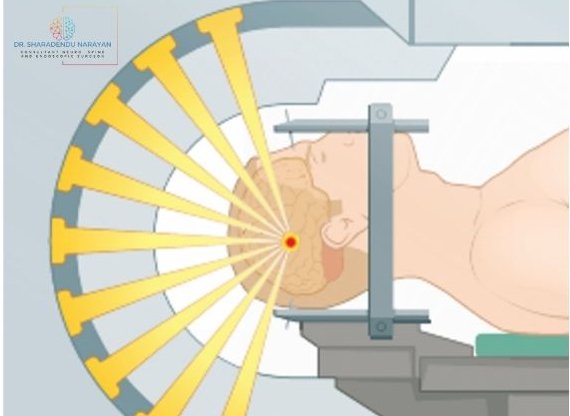Stereotactic Radiosurgery in Jamshedpur

What is Stereotactic Radiosurgery?
Dr. S. Narayan, the best neurosurgeon in Jamshedpur, offers stereotactic radiosurgery, a non-surgical procedure that delivers precisely targeted radiation to specific areas within the brain or spine. Despite its name, radiosurgery does not involve traditional surgical incisions. Instead, this procedure utilizes highly focused radiation beams to destroy abnormal tissue while minimizing damage to surrounding healthy tissue. Consequently, this surgery makes an ideal treatment option for patients who may not be candidates for conventional surgery or who prefer a non-invasive approach.
Key Benefits of Stereotactic Radiosurgery by Dr. S Narayan – Best Neurosurgeon in Jamshedpur
High Precision: Advanced imaging techniques and computerized treatment planning empower neurosurgeons to precisely target tumors and other lesions within the brain or spine. As a result, this approach minimizes radiation exposure to surrounding healthy tissue. This precision enhances the effectiveness of the treatment and promotes better patient outcomes
Non-Invasive: Unlike traditional surgery, this surgery does not require incisions or general anesthesia. Consequently, this approach results in minimal discomfort for patients. Moreover, it leads to shorter recovery times compared to conventional surgical methods. Additionally, the reduced risk of complications further enhances its appeal as a treatment option.
Versatility: Stereotactic radiosurgery can effectively treat a variety of neurological conditions. For example, it is commonly used for brain tumors and arteriovenous malformations (AVMs). Furthermore, it provides relief for patients suffering from trigeminal neuralgia. Additionally, this technique can help manage certain movement disorders, such as essential tremor.
Single-session Treatment: In many cases, patients can complete stereotactic radiosurgery in a single outpatient session. This aspect offers a convenient and efficient treatment option. Consequently, individuals can receive effective care without the need for extensive hospital stays or lengthy recovery periods.
Conditions Treated with Stereotactic Radiosurgery
Brain Tumors: Surgery serves as an effective treatment option for both primary and metastatic brain tumors. It provides precise radiation delivery while minimizing the risk of damage to nearby healthy brain tissue. As a result, patients can receive targeted treatment with fewer side effects. This approach enhances the overall effectiveness of brain tumor management
Arteriovenous Malformations (AVMs): Radiosurgery effectively targets and obliterates abnormal blood vessels associated with arteriovenous malformations (AVMs). By doing so, it reduces the risk of bleeding and alleviates associated symptoms. Consequently, patients can experience significant relief and a lower chance of complications. This targeted approach enhances overall treatment outcomes for those affected by AVMs.
Trigeminal Neuralgia: This effectively provides long-term relief from the debilitating facial pain associated with trigeminal neuralgia. This procedure works by selectively targeting the trigeminal nerve. As a result, patients can experience significant pain reduction and improved quality of life. Furthermore, this treatment option minimizes side effects compared to traditional surgical approaches.
Movement Disorders: Stereotactic radiosurgery can treat certain movement disorders, including essential tremor and Parkinson’s disease. This procedure effectively modulates abnormal neuronal activity, which helps alleviate symptoms. Consequently, patients may experience improved motor function and a better overall quality of life. Additionally, this non-invasive approach minimizes risks associated with traditional surgical techniques.
Frequently Asked Questions
It is a non-invasive procedure that delivers precisely targeted radiation to specific areas within the brain or spine to treat conditions such as brain tumors, arteriovenous malformations (AVMs), and trigeminal neuralgia.
This uses highly focused radiation beams to destroy abnormal tissue while sparing surrounding healthy tissue. Advanced imaging techniques and computerized treatment planning ensure precise targeting of the treatment area.
It is used to treat a variety of neurological conditions, including brain tumors (both primary and metastatic), AVMs, trigeminal neuralgia, and certain movement disorders like essential tremor.
Yes, Stereotactic radiosurgery is considered safe and effective when performed by experienced neurosurgeons using state-of-the-art technology. It is a non-invasive procedure that does not require incisions or general anesthesia, minimizing the risk of complications.
In many cases, this surgery can be completed in a single outpatient session, although the duration of treatment may vary depending on the specific condition being treated and the treatment plan developed by the neurosurgeon.
Key benefits of this surgery include high precision, non-invasiveness, versatility in treating various neurological conditions, and the ability to provide single-session treatment in many cases.
Candidates for stereotactic radiosurgery are typically determined based on a comprehensive evaluation by a neurosurgeon and may include patients with brain tumors, AVMs, trigeminal neuralgia, or certain movement disorders who are not suitable candidates for traditional surgery or who prefer a non-invasive approach.
